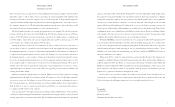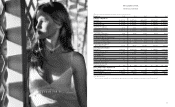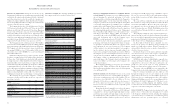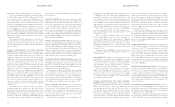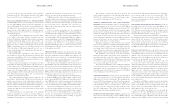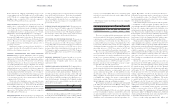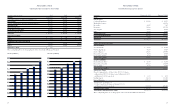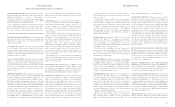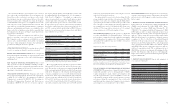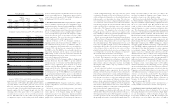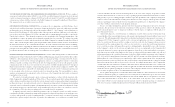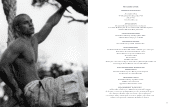Abercrombie & Fitch 2004 Annual Report Download - page 12
Download and view the complete annual report
Please find page 12 of the 2004 Abercrombie & Fitch annual report below. You can navigate through the pages in the report by either clicking on the pages listed below, or by using the keyword search tool below to find specific information within the annual report.
to $215 million is planned to be for the construction of approxi-
mately 87 new stores as well as the remodeling of 25 to 35 existing
stores. The balance of the capital expenditures will primarily relate
to a new home office building and other miscellaneous home office
and distribution center projects.
The Company intends to add approximately 520,000 gross
square feet of stores in the 2005 fiscal year, which will represent a
9% increase over year-end 2004. Management anticipates the
increase during fiscal 2005 will be due to the net addition of
approximately 67 new Hollister stores, 5 RUEHL stores and 5
international stores. Additionally, the Company plans to remodel
25 to 35 Abercrombie & Fitch stores and convert a total of 9
Abercrombie & Fitch and abercrombie stores to 8 Hollister stores
and one RUEHL store. In addition the Company plans to open a
new 34,000 gross square foot flagship store on the corner of Fifth
Avenue and 56th Street in Manhattan, New York and expand its
store in The Grove in Los Angeles by approximately 14,000 gross
square feet.
The Company estimates that the average cost for leasehold
improvements and furniture and fixtures for new Abercrombie &
Fitch stores, excluding the above mentioned New York and Los
Angeles flagship stores, opened during the 2005 fiscal year will
approximate $618,000 per store, net of construction allowances. In
addition, initial inventory purchases for the stores are expected to
average approximately $270,000 per store.
The Company estimates that the average cost for leasehold
improvements and furniture and fixtures for new abercrombie
stores opened during the 2005 fiscal year will approximate
$581,000, net of construction allowances, per store. In addition,
initial inventory purchases are expected to average approximately
$130,000 per store.
The Company estimates that the average cost for leasehold
improvements and furniture and fixtures for new Hollister stores
opened during the 2005 fiscal year will approximate $613,000, net
of construction allowances, per store. In addition, initial inventory
purchases are expected to average approximately $190,000 per store.
Although the Company opened four RUEHL stores during
the 2004 fiscal year, it believes that the costs it has incurred to-
date for the stores are not representative of the future average cost
of opening a store.
The Company expects that substantially all future capital
expenditures will be funded with cash from operations. In addi-
tion, the Company has $250 million available (less outstanding
letters of credit) under its Credit Agreement to support operations.
CRITICAL ACCOUNTING POLICIES AND ESTIMATES The
Company’s discussion and analysis of its financial condition and
results of operations are based upon the Company’s consolidated
financial statements, which have been prepared in accordance with
accounting principles generally accepted in the United States
(“GAAP”). The preparation of these financial statements requires
the Company to make estimates and assumptions that affect the
reported amounts of assets, liabilities, revenues and expenses. Since
actual results may differ from those estimates, the Company revises
its estimates and assumptions as new information becomes available.
The Company’s significant accounting policies can be found
in the Notes to Consolidated Financial Statements (see Note 2 of
the Notes to Consolidated Financial Statements). The Company
believes that the following policies are most critical to the portray-
al of the Company’s financial condition and results of operations.
Revenue Recognition - The Company recognizes retail sales at
the time the customer takes possession of the merchandise and pur-
chases are paid for, primarily with either cash or credit card.
Catalogue and e-commerce sales are recorded upon customer
receipt of merchandise. Amounts relating to shipping and handling
billed to customers are classified as revenue and the direct shipping
costs are classified as cost of goods sold. Employee discounts are
classified as a reduction of revenue. The Company reserves for sales
returns through estimates based on historical experience and vari-
ous other assumptions that management believes to be reasonable.
The Company accounts for gift cards by recognizing a liabili-
ty at the time when a gift card is sold. Revenue is recognized when
the gift card is redeemed for merchandise. The Company reviews
its gift card liability at least annually and adjusts the liability based
on historical redemption patterns as required.
Inventory Valuation - Inventories are principally valued at the
lower of average cost or market, on a first-in first-out basis, utiliz-
ing the retail method. The retail method of inventory valuation is
an averaging technique applied to different categories of inventory.
At the Company, the averaging is determined at the stock keeping
unit (“SKU”) level by averaging all costs for each SKU. An initial
markup is applied to inventory at cost in order to establish a cost-
to-retail ratio. Permanent markdowns, when taken, reduce both
the retail and cost components of inventory on hand so as to main-
tain the already established cost-to-retail relationship. The use of
the retail method and the recording of markdowns effectively val-
ues inventory at the lower of cost or market. The Company fur-
ther reduces inventory by recording an additional markdown
reserve using the retail carrying value of inventory from the season
just passed. Markdowns on this carryover inventory represent esti-
mated future anticipated selling price declines.
Additionally, as part of inventory valuation, an inventory
shrinkage estimate is made each period that reduces the value of
inventory for lost or stolen items. Inherent in the retail method
Abercrombie &Fitch
21
Abercrombie &Fitch
$42.8 million were outstanding under the Credit Agreement at
January 29, 2005 and January 31, 2004, respectively. No borrowings
were outstanding under the Credit Agreement at January 29, 2005
or January 31, 2004.
The Company has standby letters of credit in the amount of $4.7
million that are set to expire during the fourth quarter of the 2005 fis-
cal year. The beneficiary, a merchandise supplier, has the right to
draw upon the standby letters of credit if the Company authorizes or
files a voluntary petition in bankruptcy. To date, the beneficiary has
not drawn upon the standby letters of credit.
OFF-BALANCE SHEET ARRANGEMENTS The Company does
not have any off-balance sheet arrangements or debt obligations.
CONTRACTUAL OBLIGATIONS As of January 29, 2005, the
Company’s contractual obligations were as follows:
Payments due by period (thousands):
Contractual Less than More than
Obligations Total 1 year 1-3 years 3-5 years 5 years
Operating
Lease $1,256,107 $164,577 $323,255 $282,525 $485,750
Obligations
Purchase
Obligations $ 222,404 $215,971 $ 6,433 – –
Other
Obligations $ 65,167 $ 64,372 $ 795 – –
Totals $1,543,678 $444,920 $330,483 $282,525 $485,750
The majority of the Company’s contractual obligations are
made up of operating leases for its stores (see Note 5 of the Notes
to Consolidated Financial Statements). The purchase obligations
category represents purchase orders for merchandise to be deliv-
ered during Spring 2005 and commitments for fabric to be used
during the next several seasons. Other obligations represent pre-
ventive maintenance contracts for the 2005 fiscal year and letters of
credit outstanding as of January 29, 2005 (see Note 8 of the Notes
to Consolidated Financial Statements). The Company expects to
fund all of these obligations with cash provided from operations.
STORES AND GROSS SQUARE FEET Store count and gross
square footage by brand were as follows:
Number of Stores January 29, 2005 January 31, 2004
Abercrombie & Fitch 357 357
abercrombie 171 171
Hollister 256 172
RUEHL 4 –
Total 788 700
Gross square feet at
period-end (thousands) January 29, 2005 January 31, 2004
Abercrombie & Fitch 3,138 3.152
abercrombie 752 753
Hollister 1,663 1,111
RUEHL 37 –
Total 5,590 5,016
Average store size at
period-end (gross square feet) January 29, 2005 January 31, 2004
Abercrombie & Fitch 8,790 8,828
abercrombie 4,399 4,401
Hollister 6,495 6,461
RUEHL 9,350 –
Total 7,094 7,165
CAPITAL EXPENDITURES AND LESSOR CONSTRUCTION
ALLOWANCES Capital expenditures totaled $185.1 million, $159.8
million and $145.7 million for the 2004, 2003 and 2002 fiscal years,
respectively. Additionally, the non-cash accrual for construction in
progress decreased $15.5 million and $12.7 million in fiscal 2004 and
fiscal 2002, respectively, and increased $18.6 million in fiscal 2003.
Capital expenditures in the 2004 fiscal year related primarily to new
store construction in addition to approximately $15.4 million invested
in information technology, home office expansion and distribution
center projects. Capital expenditures in the 2003 fiscal year related
primarily to new store construction with approximately $35.0 mil-
lion invested in home office expansion, information technology,
including a new point-of-sale system and distribution center projects.
Capital expenditures in the 2002 fiscal year related primarily to new
store construction with approximately $20.0 million invested in
information technology and distribution center projects.
Lessor construction allowances are an integral part of the deci-
sion making process for assessing the viability of new store leases.
In making the decision whether to invest in a store location, the
Company calculates the estimated future return on its investment
based on the cost of construction, less any construction allowances
to be received from the landlord. The Company received $55.0
million, $60.6 million and $52.7 million in construction
allowances during the 2004, 2003 and 2002 fiscal years, respective-
ly. For accounting purposes, the Company treats construction
allowances as a deferred lease credit which is amortized to reduce
rent expense on a straight-line basis over the life of the leases in
accordance with Statement of Financial Accounting Standards
No.13, “Accounting for Leases” and Financial Accounting
Standards Board Technical Bulletin No. 88-1, “Issues Relating to
Accounting for Leases”.
The Company anticipates spending $240 million to $250 million
in the 2005 fiscal year for capital expenditures, of which $205 million
20





